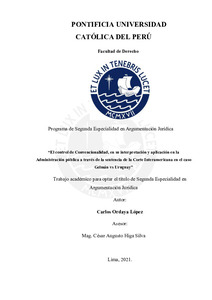| dc.contributor.advisor | Higa Silva, César Augusto | |
| dc.contributor.author | Ordaya López, Carlos | |
| dc.date.accessioned | 2022-04-20T23:20:17Z | |
| dc.date.available | 2022-04-20T23:20:17Z | |
| dc.date.created | 2021 | |
| dc.date.issued | 2022-04-20 | |
| dc.identifier.uri | http://hdl.handle.net/20.500.12404/22168 | |
| dc.description.abstract | El control de convencionalidad desde su creación jurisprudencial, desde el año
2006 (en caso Almonacid Arellano vs Chile), ha establecido un tipo de mecanismo
de control entre las normas internas de cada Estado y la Convención Americana de
derechos humanos. Es en el caso, que las primeras contravengan a las segundas. Si
bien este mecanismo de control fue desde un inicio para los jueces de los Estados
parte, sin embargo, esto ha evolucionado a la fecha, llegando a ampliarse a otros
operadores de justicia, incluso a los de la administración pública, conforme lo
establece la sentencia de fondo y Sentencia de cumplimiento de la Corte IDH.
“Gelmán y otros vs Uruguay”, donde establece que no solo es una facultad para los
jueces, operadores de justicia el control de convencional, sino también, para la
autoridad pública en función de su tarea encomendada por el Estado, debiendo de
primar este tipo de control a fin de garantizar los derechos establecidos en la
Convención Americana.
Por lo tanto, el presente trabajo tiene por la finalidad de identificar de qué manera se
aplicaría o se realizaría la labor interpretativa de este tipo de control por parte de la
autoridad, a raíz de esta sentencia, si es posible o no; y, como sería el procedimiento
a seguir para una correcta aplicación e interpretación de la Convención por parte de
la autoridad ante una norma interna que restringe o limita derechos humanos
establecidos en la CADH. Además, se pretende establecer el mecanismo correcto
para la aplicación e interpretación de este control, sin conllevar a inaplicar una norma
interna o interpretar indebidamente la norma con el tratado internacional, por cuanto
de acuerdo a nuestra legislación nacional y jurisprudencial, la autoridad pública no
tiene las facultades para realizar el control difuso de carácter “administrativo”. | es_ES |
| dc.description.abstract | Since its creation in 2006 (in the case of Almonacid Arellano v. Chile), the
control of conventionality has established a type of control mechanism between the
internal norms of each State and the American Convention on Human Rights. This
is in the event that the former contravene the latter. Although this control mechanism
was from the beginning for the judges of the States parties, however, this has evolved
to date, extending to other operators of justice, including those of the public
administration, as established in the judgment on the merits and Judgment of
compliance of the IACHR Court. "Gelmán et al. v. Uruguay", where it establishes
that not only is it a power for judges, operators of justice, to control conventional,
but also for the public authority in function of its task entrusted by the State, and that
this type of control must prevail in order to guarantee the rights established in the
American Convention.
Therefore, the purpose of this work is to identify how the interpretative work of this
type of control would be applied or carried out by the authority, as a result of this
sentence, if it is possible or not; and, how would be the procedure to follow for a
correct application and interpretation of the Convention by the authority before an
internal norm that restricts or limits human rights established in the ACHR. In
addition, it is intended to establish the correct mechanism for the application and
interpretation of this control, without leading to inapplication of an internal norm or
improper interpretation of the norm with the international treaty, since according to
our national legislation and jurisprudence, the public authority does not have the
authority to perform the diffuse control of "administrative" character. | es_ES |
| dc.language.iso | spa | es_ES |
| dc.publisher | Pontificia Universidad Católica del Perú | |
| dc.rights | info:eu-repo/semantics/openAccess | es_ES |
| dc.rights.uri | http://creativecommons.org/licenses/by/2.5/pe/ | * |
| dc.subject | Corte Interamericana de Derechos Humanos | es_ES |
| dc.subject | Administración pública--Control--Perú | es_ES |
| dc.title | El control de Convencionalidad, en su interpretación y aplicación en la Administración pública a través de la sentencia de la Corte Interamericana en el caso Gelmán vs Uruguay | es_ES |
| dc.type | info:eu-repo/semantics/bachelorThesis | es_ES |
| thesis.degree.name | Segunda Especialidad en ArgumentaciónJurídica | es_ES |
| thesis.degree.level | Título Profesional | es_ES |
| thesis.degree.grantor | Pontificia Universidad Católica del Perú. Facultad de Derecho. | es_ES |
| thesis.degree.discipline | Argumentación Jurídica | es_ES |
| renati.advisor.dni | 40101071 | |
| renati.advisor.orcid | https://orcid.org/0000-0002-9842-2150 | es_ES |
| renati.author.dni | 43468916 | |
| renati.discipline | 421029 | es_ES |
| renati.level | https://purl.org/pe-repo/renati/level#tituloSegundaEspecialidad | es_ES |
| renati.type | https://purl.org/pe-repo/renati/type#trabajoAcademico | es_ES |
| dc.publisher.country | PE | es_ES |
| dc.subject.ocde | https://purl.org/pe-repo/ocde/ford#5.05.01 | es_ES |






